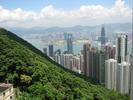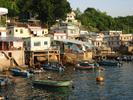Yamdroktso to Gyantse [October 4, 2002]
Day one of our Landcruiser tour. It's not possible to rent a car
and self-drive in Tibet. In fact, the car comes with both a driver and
a guide. We head out of Lhasa and drive through fields of
Monet haystacks and riverbanks lined with beech trees turning a
beautiful shade of yellow. We pass by a large Buddha
commemorating the visit of a Bangladeshi monk who
stopped there to rest in the 11th century.
Our guide translates the name of the village as
"I'm tired".
We veer off the new Shigatse road to
begin the climb up, up, up over the Khambala Pass (4794m)
to Yamdroktso lake.
The road up becomes steeper and steeper and ever more precarious
as we ascend. Eventually we are careening around switchbacks over thousand
foot drops. Passing is even more nerve-wracking and of course since we're
in a LandCruiser we pass several slower buses and trucks. Fortunately,
there is very little traffic coming the other way.
Yamdroktso Lake (N29 11.705 E90 36.940)
is a bright turquoise with the snow capped peak of Nojin Kangsan
visible in the distance about 60 km away.
The views are stunning.
Yamdroktso is one of Tibet's largest and holiest lakes
with an area of more than 600 square kilometers.
It is also one of its most endangered. A hydro power facility is
near where our road turned uphill. Water is siphoned from the lake
to drive turbines 800 meters below on the valley floor.
Some experts have estimated that
the lake will be drained in 20 years, but the Chinese deny that
there will be any environmental impact.
We continued around the lake for many miles, and then over
the Karo La pass at 5010m.
We stopped at the pass among
some Tibetan tents and a few yaks. Huge waterfalls pour off
the bottom of the snow capped mountain in the distance.
From here, we
drive through some fairly gentle, treeless brown rolling meadows
and valleys. They go for miles with subtle shades of brown, rust,
yellow, light green. We're well above the tree line here. There
are no trees and no plants other than scrubby grass
and lichens.
On to an overlook above another bright turquoise lake. This one
is man-made. The Gyantse dam is right around the corner.
We switch back down the back side of the dam and continue on
another fairly flat drive through
barley fields to Gyantse.
We visit Gyantse monastery
just before closing time. Our guide seems to know ALL the Buddhas, lamas,
guardians, and other cohorts among the thousands of statues
at each monastery we visit.
In fact, he spent several years as a monk
before he became a guide and memorization of the important figures
is part of the training.
Our hands are washed with holy water and we drink a sip to bring
us good luck. This is the first stupa we've visited that can be
seen inside. We climb to the top, but decline to pay the extra 10Y
required to bring our camera with us. Mistake. The views from the
top are spectacular.
We visit the library and one of the monks is tidying up.
One of the ``books'' in the library has its pages out and
it can be handled. It's flexible and not nearly as fragile as I
expected. The gold writing is fresh and legible. Is this
really 700 years old?
We stayed the night in Gyantse. There are a few other groups with
their own landcruisers making similar trips as ours and consequently
stopping at the same places. We had dinner with a group we keep
bumping into including Mark, an English guy who had been traveling
for nearly a year. He had all of his stuff stolen while in Chengdu,
but after waiting 17 days for a replacement passport, was on the move
again. Zivan, had been on the road for 8 months, and Carey had been
working in China and was just setting out on her trip. They, as is
common, were planning to cross the border into Nepal after visiting
Everest Base Camp.
| 








